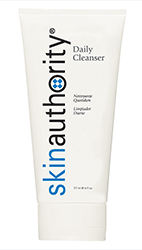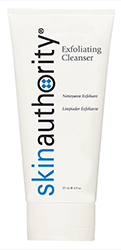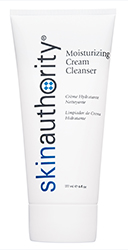Cleansing is the most basic step in any skin care routine. At Skin Authority, we think of this step as your BeautyWorkout warm-up. With so many cleansing options these days (cleansers, oils, scrubs, pads, wipes, brushes, etc.) it is more confusing than ever to know how you should be washing your face to get the best results and the most effective cleanse. This is the first of a three-part series that will give you the tools you need to find the facial cleansing routine that is right for you.
- Part 1: The Basics
- Part 2: Cleansing Like A Pro
- Part 3: Resurfacing Transformation
Part 1: The Basics
Why Cleanse?
Cleansing is the most fundamental step to healthy skin. Even though you think you should be able to lather up with soap, give a good scrub, and rub dry, those methods will imbalance and irritate your skin rather than help. The skin on your face is constructed with smaller skin cells and needs less physical scrubbing than body skin. When you wash your face, your goal should be to get rid of the dirt, dead skin cells, makeup, pollutants, microorganisms, and excess oil.
Special Attention for Your Face
Can you wash your face and body in the same way? Unfortunately, no. We will go more in depth on body cleansing in future posts, but for now, let’s look at the basic differences between cleansing your face and body. The skin on your face is more delicate, with smaller cells than your body. Moisture is lost more quickly here than elsewhere on your body, so you need to be particularly diligent about facial care and moisturization. Your skin produces oil naturally, called sebum, but if you strip too much of this natural, protective barrier away, you will cause dryness. Drying your face out with improper cleansing can lead to subsequent over-production of oil to try to compensate.
Facial Cleansing Basics
Let’s now look at the basics of daily facial cleansing. You should be washing your face once in the morning and once in the evening, but lets take a closer look at why you need to do this. Before cleansing, your skin is covered in a layer of dead skin cells, bacteria, pollutants, viruses, and dirt. Because you shed 50 million dead skin cells everyday, that layer is continually growing thicker or being replaced. The sebum that you produce mixes with sweat and the keratinized cells as they all travel up and out of your pores. The mixture spreads and hardens to form an armor-like coating to protect against the bacteria, dirt, and viruses trying to enter the body through the skin. This coating is reinforced with fatty acids to keep it together. These fatty acid needs to be dissolved to break this layer free. So picking the cleanser with the right ingredients strong enough to break these bonds is essential. Just washing with a detergent-based cleanser is not enough. An anti-bacterial cleanser won’t do it either. You need to wash twice daily with a cleanser that contains AHAs, which are known to break these bonds. You should limit your cleansing to morning, post-workout, and evening, as over cleansing can lead to dry, irritated skin. Your skin changes between seasons and as the years go by, so listen to what your face is telling you. Do not feel stuck in following the same cleansing routine or using the same cleanser year in and year out.
Ask your skin coach: How should I remove my makeup?
Iris, Skin Authority Skin Coach: Begin by removing your mascara with your Daily Cleanser or Moisturizing Cream Cleanser before moving onto your full face cleanse. These cleansers can double as a makeup remover, so there is no need to add an extra step and product to remove makeup.
How to Cleanse
Now that we know why we need to cleanse and how often, we can move onto the important how to cleanse. It is important to wash your face the correct way, so you do not aggravate or create skin problems that did not exist before. Use a comfortable water temperature, but not too hot, as hot water can strip natural oils from your skin. If you think that using a higher temperature will help your open your pores for a deeper cleanse, it is important to note that pores do not open and close. There are no scientific backings to support opening your pores with steam or closing them with ice. There are a variety of different cleansing tools you can use, which we will take an in-depth look at in the second part of this cleansing series. For basic cleansing, stick to using your fingers and stay away from washcloths. Scrubbing with a washcloth aggressively can be abrasive and can redistribute bacteria across your freshly cleansed face, if not cleaned frequently enough. Also try to stay away from makeup removing wipes as your main method of cleansing because they skip the rinsing step, leaving a portion of the day’s grime on your face. They can be convenient for taking off your makeup before the gym or for a quick cleanse after a sweat session, but as convenient as they are, they are not as effective as they seem. They can be a good way to remove makeup before cleansing, but follow with a cleanser to ensure clean skin.
To apply your cleanser, put a dime size of product in your palm and rub your hands together. On a dry face, start to apply to the middle of your face, around your nose area. Move your hands upwards to your forehead and back down around the orbital bones until you reach your cheeks and chin. Once your cleanser no longer has much “slip,” wet your hands with luke warm water and continue your cleanse. Starting at the chin, use your fingertips to make small, upward, circular motions. Repeat this on your entire face from bottom to top, massaging in the cleanser. When cleansing your neck, follow these same steps, moving bottom to top and always using upward motions.
Do not rush though this process. Especially on areas with folds, wrinkles, creases (such as the sides of the nose), and areas with texture, really take the time to work in the product and give a good rinse to make sure you are cleansing the whole face and not missing these harder-to-clean areas. When you have thoroughly cleansed and rinsed, pat dry with a towel.
Here’s a recap of the steps to cleanse:
- Choose the right cleanser
- Apply to dry skin
- Lather with warm water
- Rinse thoroughly
- Pat dry
Choosing the Right Cleanser
There are many different considerations in choosing the right cleanser, so do not think that because one works for someone else, it will be ideal for you. Skin conditions, gender, ethnicity, and even different geographic locations or seasons can influence the cleanser that is right for you. As a general rule, people tend to crave more moisture in the winter, so you may use a more moisturizing cream cleanser during the colder, dryer months than you do during the rest of the year. Everyone should also avoid products with fragrances, as they are a leading cause of irritation from skin care products; parabens, which are potentially toxic preservatives; and soap, which is drying. Today, there are sophisticated cleansing ingredients, so choosing the right cleanser for your skin will not strip the skin of oils while adding moisturization and anti-aging properties. In the past, toners have been used to balance pH levels and calm the skin, but now with the right cleanser, this step is unnecessary.
Although your skin may feel different at different times of the year, an easy way to identify a cleanser that would work for you is by skin type:
- Normal to Dry: a Daily Cleanser that balances your skin’s pH and prepares it for treatment
- Dry/Dehydrated: a Moisturizing Cream Cleanser to add some moisture back to your skin to balance and prepare
- Normal to Oily: an Exfoliating Cleanser to clear skin congestion, balance, and prepare
Oily Skin
If you have oily skin, you may be tempted to over cleanse in an attempt to make you skin less oily. Keep in mind that even though you do not like your skin overproducing oil, that does not mean you want dry skin either. You may think that over-drying your skin by frequently washing or using drying products will lead to equilibrium, but it reacts by thinking it needs to produce even more oil. Additionally, though dry skin may have fewer breakouts, it also lacks protection from the elements and is more likely to show signs of aging. Aim for balance and do not go to extreme measures that not only irritate your skin but also put you on a roller coaster ride between oily and dry skin.
Dry Skin
For dry skin, you want to stay away from cleansers that produce a lot of suds or foam. Even though the bubbles can be fun, they tend to dry skin out even more, causing redness and irritation. Instead of a cleansing gel, a cleansing cream, lotion, or oil may give you some of the moisture your skin craves.
Gender
Gender also plays a big role in choosing the right cleanser for you. Men tend to have about 25% thicker skin with tougher texture and larger pores, but lose collagen more slowly. They also have to deal with shaving regularly, which can cause excess irritation to skin. Studies also suggest that men may not be able to heal wounds as easily as women, so it is important that men’s skin care is specifically formulated to protect and repair the skin.
Ethnicity
Ethnicity can affect the type of cleanser that is best for you, but also remember that different skin types still exist within and across ethnicities. People with darker skin tones tend to have more sensitive skin. Cleansing products with abrasive exfoliants or chemicals like benzoyl peroxide can be too harsh and cause problems. Again remember, there is no single miracle cleanser so one that works for you may not be ideal for someone else.
What about oil cleansers?
There is a big trend towards oil cleansers at the moment, but this is coming on the heels of the everything-oil-free trend. So which is better? Even though different types of cleansers can benefit different skin types, it is looking like all skin types can benefit from using an oil cleanser. One thing to be cautious of: oil-based cleansers do not leave the squeaky-clean feeling to which you may be accustomed, so do not try to over scrub if you are using a washcloth or cleansing brush.
In the next part of this series we will be discussing how to take cleansing to the next level and expanding on exfoliations, masks, tools, and more. If you have any questions you would like us to answer in this series, please submit them to the comments below. Do not miss out on the next post of this three-part series: be sure to enter your email address in the “subscribe” box to the left!
Ask your skin coach: Which Skin Authority cleanser is right for me?
Normal to Dry Dry/Dehydrated Normal to Oily
Image via Huffington Post





Great article on something so basic. I know some guys think that because they shave, they don’t have to cleanse their face. In fact, it’s just as important for guys to include a cleansing step in their routine, even if they shave. I find that a quick cleanse before shaving, gives you a closer shave because you remove a lot of the surface build-up that gets in the way of the blade. (Plus, you don’t shave your upper cheeks and forehead, so you want to get those clean as well.) I also, follow shaving with a conditioning toner to remove any shaving residue and balance my skin (normalize pH).